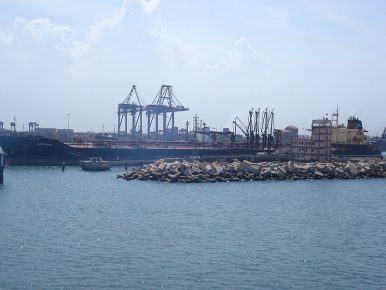By Aman Thakker
 During the recently concluded monsoon session of India’s Parliament, the Lok Sabha, or lower house of Parliament, passed 21 bills, including amendments to the various Goods and Services Tax Acts and the Insolvency and Bankruptcy Code. However, one key reform bill, which has been pending before the body since 2016, was not considered or passed. That bill is the Major Port Authorities Bill, 2016, which would overhaul the management of the major ports of India. This reform on major ports is crucial given the impact India’s inefficient ports have on government priorities such as Make in India and improving ease of doing business. While the bill aims to improve efficiency and ensure rapid and transparent decision-making by transforming how the ports are managed, progress has not yet been made on this bill.
During the recently concluded monsoon session of India’s Parliament, the Lok Sabha, or lower house of Parliament, passed 21 bills, including amendments to the various Goods and Services Tax Acts and the Insolvency and Bankruptcy Code. However, one key reform bill, which has been pending before the body since 2016, was not considered or passed. That bill is the Major Port Authorities Bill, 2016, which would overhaul the management of the major ports of India. This reform on major ports is crucial given the impact India’s inefficient ports have on government priorities such as Make in India and improving ease of doing business. While the bill aims to improve efficiency and ensure rapid and transparent decision-making by transforming how the ports are managed, progress has not yet been made on this bill.
Challenges Facing India’s Major Ports
India’s ports are currently divided into two categories. Major ports today, such as Chennai, Jawaharlal Nehru Port, Kolkata, Mumbai, and Visakhapatnam, are administered, maintained and developed by the Central Government under the authority of the Major Port Trusts Act, 1963. Under this act, major ports are governed by a board of trustees appointed by the central government, who are subject to directives and orders from the Ministry of Shipping. Moreover, major ports in India are also subject to tariff regulations dictated by a central government regulatory.
However, India also has over 200 minor and intermediate ports that are privately-owned and operated. Such ports are not governed by the same Major Port Trusts Act, but rather by subject to administrative oversight from state governments. These private ports do not also face the same tariff regulations as major ports, allowing market rates to prevail in minor and intermediate ports.
As a result of these differences in governance, oversight, and tariffs, India’s major have continued to face obstacles in efficiency and growth, while non-major ports have continued to perform better and be more efficient. Indeed, according to data from the World Bank that indexes the performance of ports in South Asia, India’s Mundra and Pipavav ports are among the highest performers, ranked at 4th and 3rd respectively, while the ports of Chennai, New Mangalore, and Kolkata lag far behind.
The tariff regulations major ports face also contribute to their lack of efficiency and growth. Because non-major ports are not subject tariff regulations, they can offer market rates as well as customized services. However, the lack of such flexibility on tariff rates for major ports has meant they cannot compete effectively with minor and intermediate ports. Indeed, privately-operated non-major ports grew 16 percent in the FY 2015-16, compared to major ports, which only grew 3 percent during the same time frame.
The Need for Reform
Given the structural obstacles facing India’s major ports, the government drafted a bill in 2016 that would replace the Major Port Trusts Act, 1963 and bring the best practices used in the administration of non-major privately-administered ports. Indeed, the government outlined that the aim of the bill is to “empower the 12 major ports to perform with greater efficiency on account of full autonomy in decision making.”
One of the biggest reforms outlined by the bill is to transform the governance structure of the major ports by replacing the old Board of Trustees with a Board of Port Authority with greater autonomy that is line with global standards. The bill outlines that the new Board would have new powers “to use its property, assets and funds in such manner and for such purposes as it may deem fit for the benefit of the major ports.”
Moreover, the government is also opening membership in the board to allow for faster and more transparent decision-making. While the Central Government will still nominate members to the new Board, there is a provision in the latest amendments to the bill for between two and four independent board members, as well two members representing port employees. This reform is crucial as the World Bank study noted that “The main difference between the ports of Mundra and Pipavav and traditional public port authorities is the presence of independent members,” and that the presence of independent members is likely to enhance board functioning.
The bill also recognizes that “the regulation of tariff in the major ports by the Central Government are some of the critical factors hindering their growth and development.” Accordingly, the Board, and any committees it appoints, are empowered determine tariff rates according to the latest draft of the bill. These powers extend to tariff rates for port services, access and use of port assets, and determining rates for different types of goods and vessels at the port.
According to latest data, 95 percent of India’s trading by volume and 70 percent by value is done through maritime transport. With rising traffic at ports, as well as India’s focus to improve investment flows and ease of doing business, it must reform the governance of its ports, and it must make progress on the Major Port Authorities Bill, 2016.
No comments:
Post a Comment